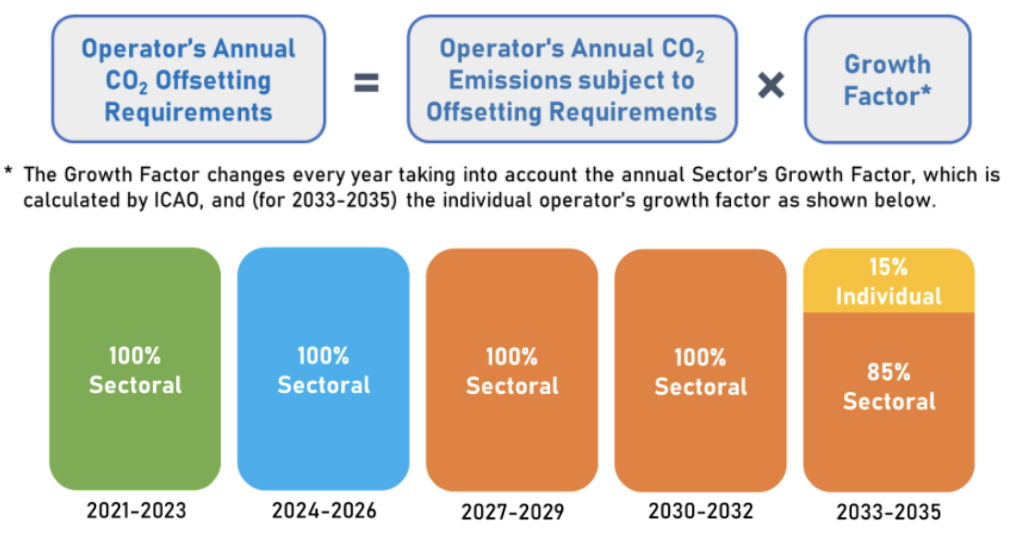A guide to CORSIA: unlocking aviation's green potential


· 5 min read
This article is part of illuminem's Carbon Academy, the ultimate free and comprehensive guide on key carbon concepts
According to the Intergovernmental Panel on Climate Change IPCC, the aviation sector is responsible for approximately 2 percent of global CO2 emissions produced by human activity.
Developed in 2016 by the International Civil Aviation Organization (ICAO), CORSIA (Carbon Offsetting and Reduction Scheme for International Aviation) enforces carbon-neutral growth for the international Aviation sector from 2021. CORSIA is the first global market-based initiative offering a harmonized mechanism to reduce emissions from a specific sector.
Below we offer a brief overview of the main aspects of CORSIA based on information gathered from ICAO’s website.
The CORSIA consists of three phases:
The difference between the phases lies in the type of State participation in the scheme: while in the pilot phase and in the first phase it is voluntary, it is mandatory in the second phase.
The table below illustrates the different phases of CORSIA:
N.B. Countries such as Least developed countries, small island developing states and landlocked developing countries, are exempt from all phases of CORSIA, unless they volunteer to participate in the scheme.
CORSIA follows a route-based approach:
The logic behind a route-based approach is to prevent market distortions between participating and non-participating airplane operators sharing the same routes.
From the start of CORSIA's pilot phase, all international flights between two States not participating in CORSIA for offsetting purposes are exempt from offsetting requirements. However, airplane operators not engaging in CORSIA for offsetting, yet surpassing annual CO2 emissions of 10,000 tonnes, are subject to MRV requirements (monitoring, reporting, and verification). The requirement to monitor, report and verify CO2 emissions from international aviation is thus independent from the generation of offsetting requirements.
The figure below illustrates this point clearly:
It may also be the case that an airplane operator can have offsetting requirements, even if its State of registration does not participate in CORSIA offsetting. Due to CORSIA's route-based framework, if non-participating operators conduct flights between participating States, they become subject to CORSIA's offsetting obligations, regardless of whether their State of registration participates in CORSIA or not. In other words, airline operators that are flying routes between states that have joined CORSIA do not have the choice to participate, but must do so.
To understand offsetting requirements, we first need to illustrate where the emissions baseline is set:
Calculating offsetting requirements is the result of a multi-step process involving airline companies, ICAO, and national entities:
The infographic below provides details on the formula for the calculation of offsetting requirements:
Source: ICAO
In order to comply with its offsetting requirements, the airline operator purchases a number of credits from the carbon market. Typically, this offsetting process involves buying and retiring carbon credits obtained through various projects aimed at reducing or removing emissions. Retiring a carbon credit indicates that it has been used and removed from market circulation, preventing its reuse.
ICAO has tasked the Technological Advisory Board (TAB) with assessing these units for CORSIA eligibility, subject to subsequent approval by the ICAO. In Phase 1, only two standards are recognized in the market as eligible for credits: the American Carbon Registry and the Architecture for REDD+ Transactions.
CORSIA serves as a crucial framework, not only for regulating a sector responsible for substantial emissions but also for providing other benefits on a broad scale. Below, we briefly outline two of those advantages:
Are you a sustainability professional? Please subscribe to our weekly CSO Newsletter and Carbon Newsletter
illuminem briefings

Carbon · Environmental Sustainability
illuminem briefings

Carbon Regulations · Public Governance
illuminem briefings

Climate Change · Environmental Sustainability
Politico

Climate Change · Agriculture
UN News

Effects · Climate Change
Financial Times

Carbon Market · Public Governance